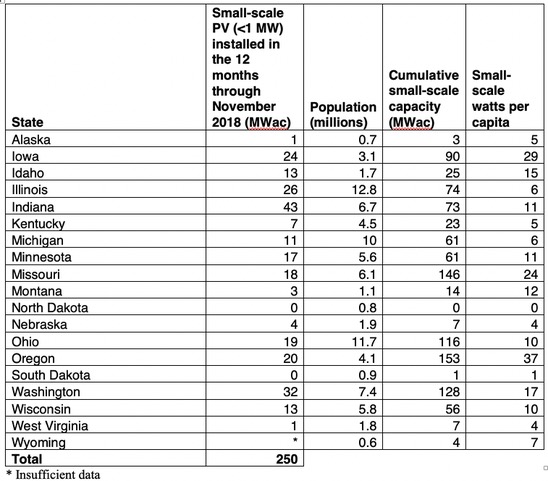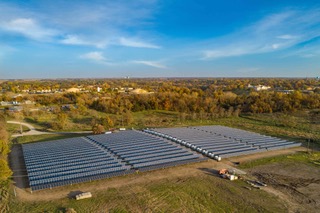Solar contractors in Midwestern and Northern Tier states put up 250 MW of small-scale (under 1 MW) solar PV systems in the twelve months ending November 2018.
Contractors in Indiana took the lead across this 19-state area, followed by Washington, Illinois, and Iowa. Oregon retains its lead in solar per capita, followed by Iowa and Missouri.
Midwestern states generally added more small-scale solar, even though the solar resource is greater across Northern Tier states, as shown in a solar resource map from the National Renewable Energy Laboratory.
The Energy Information Administration (EIA) expects that 3.9 GW of small-scale solar will come online nationwide this year—nearly as much as the 4.3 GW of utility-scale PV that the agency expects.
Here are the small-scale installation data for the 19 states, as shown in EIA’s Form EIA-861M reports:

At least some states had higher totals for distributed solar installations—i.e., all those installations not directly connected to the bulk transmission grid. That’s because some distributed installations are substantially larger than the 1 MW cutoff that EIA uses to define small-scale solar. EIA does not separately report data on all distributed solar installations.
Policy goals
Policy experts in these states offered their goals for advancing distributed solar in the coming year:
Illinois
The national solar group SEIA is “working to ensure smooth implementation of Illinois’ Adjustable Block Program, and will work with Rep. Davis on legislative improvements to the Illinois Renewable Portfolio Standard,” said Sean Gallagher, SEIA’s vice president of state affairs.
The regional environmental group ELPC is working with a broad coalition to expand the state’s targets for new wind and solar development, including distributed generation, said ELPC Senior Attorney Bradley Klein.
Michigan
ELPC is working in the state to “push back against utility proposals to restrict and penalize customers who choose to invest in on-site solar,” said Mr. Klein.
Montana
The Montana Renewable Energy Association is working to “protect Montana’s net metering program, both in the legislature and in the open general electric rate case docket. We need sound policies that will allow our local industry to grow,” thus serving the state’s demand for solar, said the group’s Executive Director Andrew Valainis.
Wisconsin
As in Michigan, ELPC is working in Wisconsin to defend policies that support customers who choose to invest in on-site solar, said Mr. Klein.
Across the Midwest
“With new, pro-solar governors in office across the region, the prospects for clean energy are bright,” said Sean Gallagher of SEIA.
Snapshot stories
Here are “snapshot stories” provided by solar companies, presenting projects from the past year:

This 155kW solar array in Mishawaka, Indiana, is one of the state’s largest solar projects for a confined animal feeding operation. Built by Emergent Solar Energy. Image: Jeremy Lipinski, Emergent Solar Energy

This 151.04 kW install in Oakwood, Ohio net meters two hog barn buildings. Built by Ag Technologies of Rochester, Indiana. Image: Ag Technologies

This 1.1 MW PV system includes 1 MWh of vanadium-flow battery storage, and serves the Maharishi University of Management in Fairfield, Iowa; all electricity generated is consumed on-site. Built by Ideal Energy. Image: Ideal Energy Inc.
This content is protected by copyright and may not be reused. If you want to cooperate with us and would like to reuse some of our content, please contact: editors@pv-magazine.com.







Some thoughts on this in general… EIA doesn’t track realtime data, but rather generators report monthly data. Generally, EIA’s data is based on operating units and production is reported separately based on fuel used. There are substantial reporting for units below the 1 MW cutoff… every turbine is tracked/reporting; i.e., small single cycle turbines at landfill facilities, generally 0.1 MW. Fuel Cells are also reporting under 1 MW.
Maybe it is time for DG solar (and their aggregators where appropriate) to push the issue & report like any other generator in the US??? EIA has no more/no less capacity to plan realtime or forward forecasts, than do most generation entities. Their [EIA] data is “After the fact”.